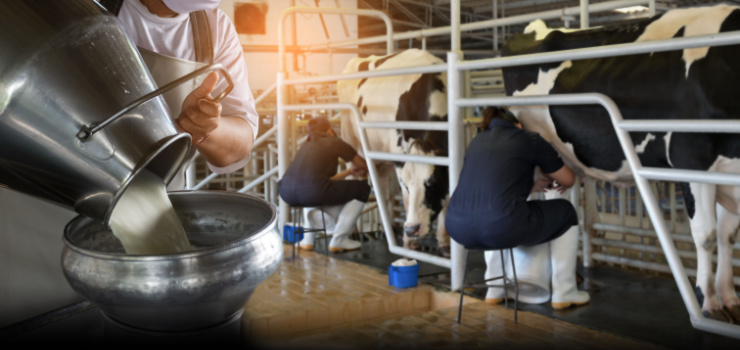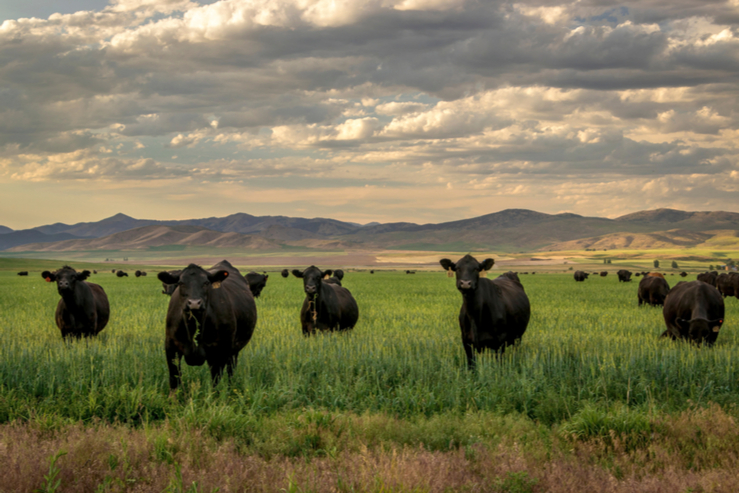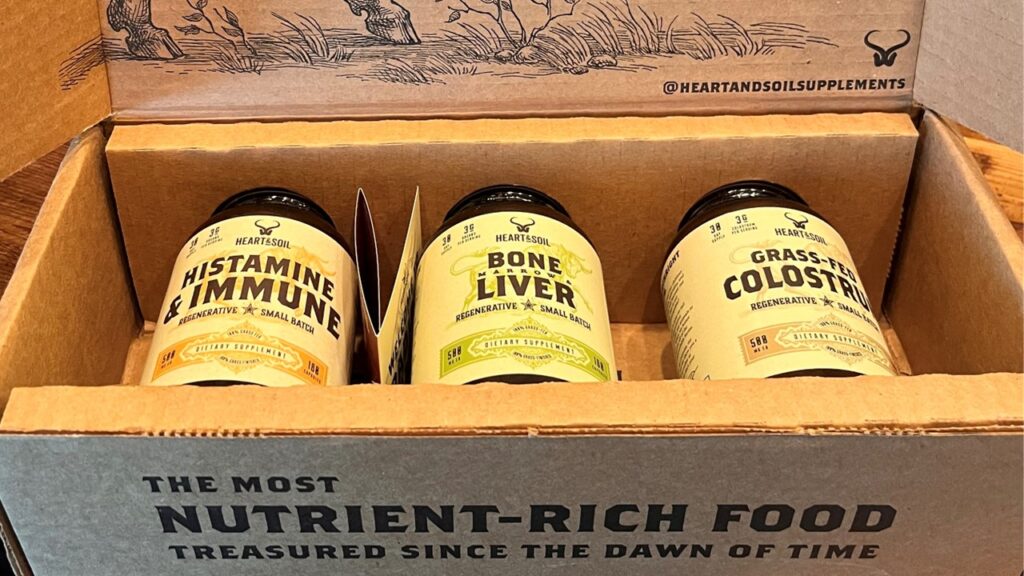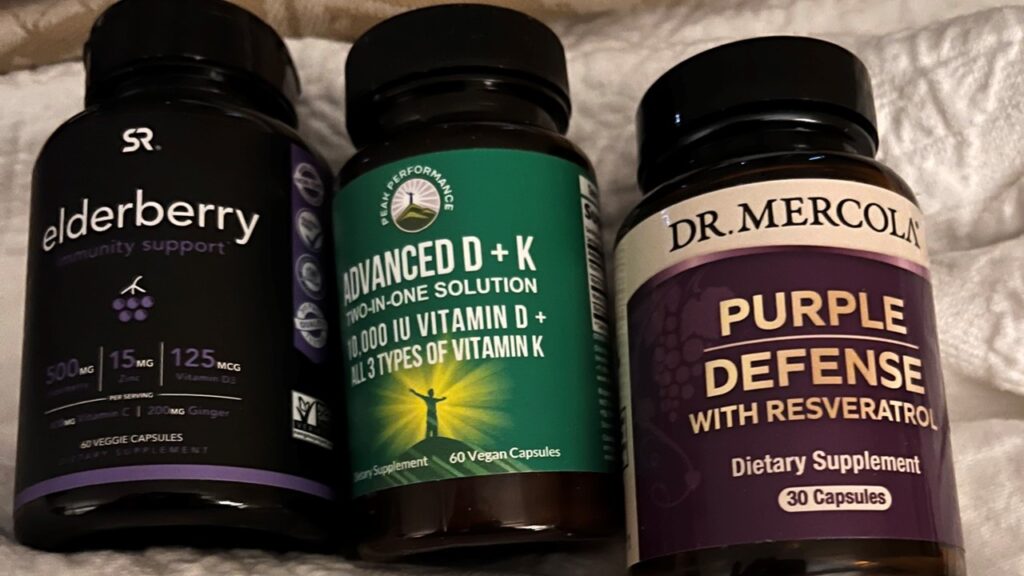
At Soil Health Academy, Ron Nichols tells the story of Ashley Armstrong, who forsook her training as a mechanical engineering PhD to pursue regenerative farming. Ashley and her sister Sarah run Angel Acres farm, raising chickens for eggs and meat, dairy goats, and hogs. (Read more about the anti-inflammatory benefits of choline in eggs from chickens like those on Angel Acres here). Nichols writes:
Although it seems like a big departure from a career in academia or in the mechanical engineering industry, Ashley says her regenerative farming life and career will always be positively influenced by her years of engineering studies.
“I have to take a step back and realize that my education and experience gave me a way of thinking,” she says. “And I think that way of thinking can be applied to so many things in life—especially related to what I learned in graduate school. I had to really learn how to read research papers, how to dig through the literature, how to criticize research papers, how to find research papers. And that process has benefited me a lot in our health and wellness business, but also in the regenerative ag space.”
Ashley says the value of her advanced engineering degree isn’t a result of the things she memorized or theories she learned in specific classes, but rather how that experience has allowed her to see things from a complete, context-based perspective. “What I appreciated about my mechanical engineering degree is it gave me more of a holistic picture of how things worked or how you should think about complex problems,” she says.
Ashley says her years of engineering study also provided the basis for finding her life’s passion. “I honestly feel so blessed to be even in this position because I am happy that I found purpose, my passion, my obsession,” she says. “I found that thing that made me tick. It’s the thing I just can’t stop thinking about.”
Being able pursue her passion, and armed with a holistic engineering mindset, is what Ashley says fuels her from day-to-day. “I feel a responsibility to give as much of my life as I can to this area because it’s given me so much,” she says. “And that’s kind of what ultimately fueled my decision to pursue this because one of my mentors helped me to see it that way.”
Ashley says it’s ironic, if not perplexing, that so many people believe a career in farming is “less prestigious” than a career in academia or mechanical engineering industry.
“There’s a perception that farming is not something that we need to be a part of anymore,” she says, “because it’s industrialized and that food is taken care of by the big guys, so we don’t need to worry about it anymore.” Some of her friends and family members have asked Ashley directly why she wanted to give up a higher-paying career in academia or the mechanical engineering industry to grow food because our food needs are “taken care of.”
But for Ashley, the answer is clear. “We are seeing the consequences of someone else growing our food,” she says. “A growing number of people in my generation are saying, ‘We are going to deal with it ourselves.’”
And she’s emphatic that being a regenerative farmer isn’t a “lowly position.” “It’s the highest, the most prestigious position there is, because health is wealth,” she says, “and if we can help create healthier food, prestige doesn’t matter.”
The regenerative road to health
With more than 90,000 social media followers and customers from nearly every state, the Armstrong sisters recognize there is an appetite for food-and-health related information—and for the access to regenerative food sources. By combining honest, effective communications with the production of regeneratively grown, nutrient dense foods, Angel Acres farm (and their farm cooperative, Nourish Co-Op) is providing nourishment to the bodies and souls of their growing following.
“Everything we do revolves around health and health optimization, and I think that we bring that perspective into the regenerative ag space,” she says. “Sometimes, understanding the connection between food and health is really hard to get across unless you yourself have dealt with health challenges and health problems. We are providing really high quality food, and showing that not only does the way animals raise matter, but WHAT they eat matters, too. Which is why we made our own feed for our layer birds, meat birds, dairy goats and hogs. We are what we eat, eats, and we’ve documented this by lowering the PUFA (specifically, Linoleic Acid, an Omega 6 fatty acid high in vegetable oils) content of our eggs by changing the feed.”
Having experienced the adverse consequences of consuming nutrient-deficient food themselves, the Armstrong sisters are uniquely qualified to communicate the connection between healthier soil and healthier food. “We know, first-hand, that the first step in refining your health is prioritizing where your food is coming from,” Ashley says.
For more information about Angel Acres visit www.angel-acresfarm.com and their farm cooperative, which delivers products to all 50 states, www.nourishcooperative.com.
Read more here.
Do Cows Get Cold?

In Organic Valley’s Roostock, Jennifer McBride explains that cows don’t get too cold in a normal winter because “An adult cow has a furnace inside.” She writes:
Organic Valley farmer Gene Mohs of Minnesota may have to throw on an extra layer of clothing when he heads out the door on cold Minnesota mornings, but chances are his cows are content.
At what temperature do cows get cold? Believe it or not, cows prefer it cool — they are built for this! The ideal temperature range for dairy cattle is 25 to 65 F, according to the University of Missouri Extension. Even at temperatures of just 68 F cattle can start to feel heat stress. When temperatures dip below zero, yes, cows may get cold but Organic Valley farmers take special precautions to keep cows cozy.
How do cows stay warm? One reason cows prefer it cooler is because of all that is going on internally.
“An adult cow has a furnace inside,” said Dr. Meggan Hain, Organic Valley veterinarian. She is speaking of food that is fermenting in the rumen (the first compartment of a cow’s stomach). As the rumen breaks down forage, digestion releases gas that keeps the animal warm.
Cows also acclimate to poor conditions. In the winter, cows’ thick skin and hair is a natural insulator, like a heavy winter coat, that protects them from the bitter cold. A cow’s hair grows longer and thicker during winter weather. When it snows, the hair coat catches the snow and forms a layer that creates an air pocket between the snow and the cow’s skin. The pocket is then warmed by the cow’s core body temperature of about 101 to 102 F.
Read more here.
Got Science? The Vindication of Whole Milk

Whole milk has been maligned as unhealthy for decades despite being filled with nutrients. Now, at Mercola.com, Dr. Joseph Mercola discusses a major shift in the perception of whole milk and its potential for protecting your heart. He writes:
For decades, Americans have been told to avoid whole milk due to its saturated fat content, which has been falsely accused of clogging arteries and causing heart disease. To this day, the U.S. dietary guidelines and health authorities like the American Heart Association and the World Health Organization recommend drinking low-fat or skim milk for this reason.
However, as Dr. Dariush Mozaffarian, a cardiologist and professor of medicine at Tufts University, recently told New York Times reporter Alice Callahan,1 this guidance goes back to the first edition of the dietary guidelines, issued in 1980, and most studies performed since then have exonerated full-fat whole milk.
In fact, most studies have found that dairy products are associated with lower risks of high blood pressure, heart disease and Type 2 diabetes, regardless of fat content. What’s more, even though full-fat dairy products have higher calorie content, they don’t appear to contribute to weight gain, either.
Dairy Protects Heart Health
For example, a 2018 Lancet study,2 which followed 136,384 adults across five continents for nine years, found that, compared to those who did not consume dairy (milk, yogurt and cheese), those who consumed two or more servings per day were:
- 17% less likely to die from any cause
- 22% less likely to die from cardiovascular disease
- 34% less likely to die from a stroke
Milk and yogurt, in particular, were associated with a lower risk of mortality and/or major cardiovascular events, and there was no discernible difference between low-fat and high-fat products. Cheese and butter intake were not significantly associated with these outcomes. Serving sizes were as follows:
- Milk and yogurt — 1 cup or 244 grams
- Cheese — one slice or 15 grams
- Butter — 1 teaspoon or 5 grams
There’s More to Milk Than Milk Fat
As noted in the Lancet paper:3
“… dietary guidelines recommend minimizing consumption of whole-fat dairy products for cardiovascular disease prevention …
However, dairy products and dairy fat also contain potentially beneficial compounds — including specific amino acids, medium-chain and odd-chain saturated fats, milk fat globule phospholipids, unsaturated and branched-chain fats … vitamin K1 and K2, and calcium — and can contain probiotics, many of which also affect health outcomes.
Therefore, the net effect of dairy intake on health outcomes might not be reliably informed solely from its effect on a single risk marker (i.e., LDL cholesterol) or fatty acids.”
The authors also review the results from previous meta-analyses,4 none of which were able to discern a significant problem with dairy. For example, one meta-analysis of cohort studies found higher milk intake lowered the risk of high blood pressure while having “a neutral effect on cardiovascular disease.”
The DASH trial also found a link between milk consumption and reduced blood pressure. Other meta-analyses have punctured the LDL argument as well. One such analysis, which included 20 randomized trials, found a “non-significant” increase in LDL cholesterol among those who consumed either low-fat or high-fat dairy products. Ditto for cheese.
One potential reason for this is because milk fat is packaged in globule phospholipids, which help bind cholesterol in your digestive tract.5,6
Another large-scale trial,7 also published in 2018, which pooled results from 16 cohorts from the U.S., Europe, Australia and Taiwan, involving 63,682 individuals with a follow-up of nine years, found those with the highest levels of milk fats (odd-chain fatty acids 15:0 and 17:0, and trans-palmitoleic acid specifically) had a 29% lower incidence of Type 2 diabetes.
Read more here.
America’s Food Industry “Rife with Corruption”

At Mercola.com, Dr. Joseph Mercola explains that America’s food industry, specifically its beef industry, is “rife with corruption,” and warns consumers that their own tax dollars are being used to promote agricultural policies that are antithetical to public health. He writes:
You’re probably aware that the food industry has the power to influence your eating habits through the use of advertising and lobbying for industry-friendly regulations. But did you know the U.S. government actually funds some of these activities through the collection and distribution of taxes on certain foods?
And that by doing so, the government is actively supporting agricultural systems that are adverse to public and environmental health, and discouraging the adoption of healthier and more ecologically sound farming systems?
The beef industry in particular appears to be rife with corruption aimed at protecting big factory-style business rather than the up-and-coming grass fed industry. As explained in Washington Monthly:1
“Imagine if the federal government mandated that a portion of all federal gas taxes go directly to the oil industry’s trade association, the American Petroleum Institute [API].
Imagine further that API used this public money to finance ad campaigns encouraging people to drive more and turn up their thermostats, all while lobbying to discredit oil industry critics … That’s a deal not even Exxon could pull off, yet the nation’s largest meat-packers now enjoy something quite like it.
[W]hen you buy a Big Mac or a T-bone, a portion of the cost is a tax on beef, the proceeds from which the government hands over to a private trade group called the National Cattlemen’s Beef Association [NCBA].
The NCBA in turn uses this public money to buy ads encouraging you to eat more beef, while also lobbying to derail animal rights and other agricultural reform activists, defeat meat labeling requirements and defend the ongoing consolidation of the industry.”
Federal Tax Helps Beef Industry Promote Beef
In a nutshell, the U.S. Department of Agriculture (USDA) beef checkoff program2 is a mandatory program that requires cattle producers to pay a $1 fee per head of cattle sold.
It’s basically a federal tax on cattle, but the money doesn’t go to the government but to state beef councils, the national Cattlemen’s Beef Board (CBB) and the NCBA. All of these organizations are clearly biased toward the concentrated animal feeding operation (CAFO) model.
The money is collected by state beef councils, which keep half and send the other half of the funds to the national CBB, headquartered in Colorado, which is in charge of the national beef promotion campaign. Nationwide, the beef checkoff fees add up to about $80 million annually.
As the primary contractor for the checkoff program, the NCBA receives a majority of the checkoff proceeds, which is used for research and promotion of beef.
But while the beef checkoff program began with the best of intentions, aiming to help struggling ranchers by pooling their money to pay for the promotion of beef, discontent over how the money is being used has grown over the years.
Read more here.
What You Should Know about Raw Milk Safety

At Heart and Soil, the H&S Crew discuss the safety of raw milk, writing:
PLEASE NOTE: The information in this blog is for educational purposes only. It is not a substitute for professional medical advice. Consult your healthcare provider if you’re seeking medical advice, diagnoses, or treatment.
Is Raw Milk Safe?
Pasteurization became commonplace in the early 1900s in the United States after milk was linked to outbreaks such as tuberculosis (21). By 1900, an estimated 10% of human tuberculosis infections came from milk consumption, and in 1910, a tuberculosis epidemic impacted over 300,000 cattle in Illinois (22). But there’s a reason…
These outbreaks were often due to cows being raised in unnatural city environments, without pasture, in filthy conditions, and on poor diets (23). Cows were even fed byproducts from alcohol distilleries.
Many government agencies now ban raw milk due to prior outbreaks of pathogens such as salmonella, listeria, tuberculosis, and E. Coli (24). The CDC in the US and Health Canada advise that women, children, the elderly, and those with compromised immune systems may be at risk of serious illness from raw milk consumption (25).
Dairy can be contaminated by the passage of cow blood into the milk, fecal contamination, contact with insects, contamination from human skin, or udder infection (26).
Current outbreaks from raw milk are often connected to dairy farms that haven’t received proper training on hygienic milking or hazard reduction (27). Outbreaks connected to raw milk consumption are also subject to detection bias as it’s easier to trace issues back to a niche community with fewer consumers (28).
At this point, you may be asking, how many people actually get sick from raw milk consumption? The exact number is unclear, but here’s what we do know.
A review of dairy-associated outbreaks from 1993-2006 discovered 1,571 cases, 202 hospitalizations, and 2 deaths from unpasteurized products (29).
Another study reported these statistics on pasteurized and unpasteurized dairy outbreaks from 2005-2016 (30):
Despite increased distribution, outbreaks connected to raw milk have been declining since 2010, and the outbreak rate since 2005 has decreased by 74% (31).
Producers across the globe have demonstrated that raw milk can be produced safely (32).
Read more here.
The Grassfed Exchange

Each year, a group of regenerative ranchers, dairy producers, and sustainable food supporters from across the world come together at The Grassfed Exchange. The Grass Fed exchange is “a volunteer, non-profit organization of regenerative ranchers and grass-fed industry supporters. It is our desire to provide a means of education and exchange of grass-fed genetics between producers. With quite a few conferences behind us that have been well received, we continue to promote the grass-fed industry and grass-fed genetics through education and display. We hope you will join us at our upcoming conference.” Watch the clip below to get a good idea of what you can expect from The Grassfed Exchange:
Read more about the Grassfed Exchange here.
Dick Young’s Daily Staples
RESEARCH SOURCE: The People’s Chemist

If you’re looking for a research source that can give you an alternative perspective on medicines, visit the website of Shane Ellison, “The People’s Chemist.” Ellison writes in a recent email:
Using a glucose monitor won’t help you avoid insulin resistance, obesity or diabetes….that’s because it’s not about glucose levels.
Avoiding problems of high blood sugar is about learning how to manage insulin levels…
A glucose monitor isn’t the only waste of time.
You’re also wasting time with these tests:
– Vitamin D
– Cholesterol
– Testosterone
– COVIDAll of the above tests are nothing more than neatly-designed scams to hook you on meds…and that inevitably leads to a fast pass to death.
There are however a few tests that could save your life.
But first you need to understand a tiny bit of history.
In 1913, chemists discovered that carbohydrate consumption skyrockets blood sugar levels to dangerous levels…simple carbs like cane sugar, high fructose corn syrup, juice, soda, wine and alcohol – Basically all the stuff in your Starbucks, smoothies, bread and pasta.As simple carbs are consumed, you age prematurely and eventually die young. This is a well known process that’s important to understand if you want more energy and life.
As sugar rises, our oxygen carrying molecules are weighted down by sugar. It’s a slow suffocation. And the damage from these carbohydrates can be seen in blood tests that measure:
– Fasting Blood Sugar (not monitoring throughout the day)
– Insulin
– A1C (glycated hemoglobin)As of 2022, The Journal of the American Medical Association has declared that high blood sugar is the biggest threat to our kids and adults, stealing an average of 11 years from a persons lifespan.
The best way to find out if you’re a potential victim is to get your blood tested. These three simple blood tests can tell with reasonable certainty whether or not you’re at risk for the sugar eating disease we know as Type 2 diabetes.
The Blood Sugar TestFirst, test your fasting blood sugar.
Wake up, go to a blood lab, and have them draw blood, or buy a self-test at a grocery store. THAT’S IT.
Normal fasting blood sugar is 85 to 95 mg/dL.
If yours is higher than that, you may have some bad blood. But then again, the reading is only a snapshot. Elevated blood sugar doesn’t always mean you’re at risk, nor does a normal reading mean you’re in the clear.
The Insulin Test
Your body has the ability to hide the threat of high blood sugar with high insulin levels. This is why blood sugar levels don’t mean much by themselves. They must be coupled to insulin levels. In other words, your blood sugar might be “normal,” but your insulin might be sky high as a coping mechanism.
It’s easy to understand this…
When blood sugar rises, your pancreas attempts to protect you from the poison by increasing its production of insulin. This helps to force-feed your muscle cells the excess blood sugar, keeping excess blood sugar invisible from tests. I call it a biological coping method that gets missed ALOT!
Therefore, get your insulin levels tested.
Any doctor can do both of these for you. If you have normal blood sugar and high insulin levels, you might have “bad blood.”
The A1C Test
Both blood glucose and insulin tests are mere snapshots and don’t give a good idea of what’s happening over time. That’s why you need an A1C test. This measures how much of your hemoglobin is being attacked by excess sugar, over time.
If you have raised blood sugar for long periods, it will attach itself to hemoglobin, the oxygen-carrying molecule I mentioned above.
The process basically works like this:
Sugar floats in the bloodstream for too long, gets lonely, and then grabs onto a nearby hemoglobin molecule. The attachment gives rise to “glycated hemoglobin,” which is noted as A1C.
Since the same hemoglobin molecule lasts for about three months in your blood, an A1C test measures your blood sugar over that time. For instance, an A1C reading of 6 percent equals an average glucose of 135 mg/dL (7.5 mmol/L).
In summary, if your blood glucose reading corresponds to anything higher than 95 mg/dL, you could be in danger. Your health trajectory might be taking you toward depression, premature heart attack, stroke, cancer, and even Alzheimer’s, usually in that order.
The Weight Test
But, let’s not forget what the best indicator of high blood sugar is – your weight…
If you’re carrying a body-fat percentage of 22 percent or higher, you can bet that you’re on a downward spiral. Even 18-22% should be put in check!
You can stop this insidious outcome by forcing your body to REMOVE SUGAR with Cinnergy!
Cinnergy is an ultra-potent blend of medicinal cinnamon and milk thistle. It brings premature aging to a screeching-halt by targeting high blood glucose, liver toxicity and dementia. Coumarin-free, Cinnergy works to restore health by optimizing sugar metabolism without life threatening side-effects common to prescription meds and insulin. Regular use puts an end to high blood sugar, triglycerides, A1C and your worries of insulin resistance as well as Type II diabetes!
You’ll known Cinnergy is working because you’ll have more energy, better focus and your sugar cravings will hit a wall! Plus, your doctor will be floored over your new blood test results!
Read more here.
Lead Off Your Day Right During Flu Season
Lead off your day right during flu season with this trio of supplements I use to boost immunity.
Could Nature’s Pharmacy Hold the Key to Cancer Recovery?

Could plants hold the key to fighting cancer? The GreenMedInfo Research Group, along with GreenMedInfo founder Sayer Ji, suggests that this is the case. They write:
Imagine a future where the key to defeating cancer’s most resilient cells lies not in a high-tech lab, but in the plants around us. A groundbreaking review published in the Journal of Clinical Medicine, along with supporting research from GreenMedInfo.com’s founder Sayer Ji, suggests this future may be closer than we think. As conventional treatments struggle to overcome treatment resistance, could nature’s pharmacy hold the answer?
The Achilles’ Heel of Cancer Treatment: Stem Cells
To understand why current cancer therapies often fall short, we must first grasp a fundamental concept: cancer stem cells (CSCs). Sayer Ji, founder of GreenMedInfo.com, explains: “CSCs represent a pluripotent heterogeneous population within tumor bulk, with self-renewal and differentiation abilities, contributing to the failure of conventional therapies and, therefore, to disease relapse and metastasis” (Ji, 2012).
In simpler terms, CSCs are the troublemakers of the tumor world. They can:
- Self-renew, creating more of themselves
- Differentiate into various types of cancer cells
- Resist traditional treatments
- Lie dormant, only to reactivate and cause relapse
This resilience makes CSCs a critical target in cancer treatment. But how do we combat such a formidable foe?
The Shortcomings of Conventional Approaches
Conventional cancer treatments like chemotherapy and radiation often appear effective initially, shrinking tumors and reducing cancer cell populations. However, this success may be misleading. Ji notes, “The reality is that the chemotherapy, even though it has reduced the tumor volume, by increasing the ratio of CSCs to benign daughter cells, has actually made the cancer more malignant” (Ji, 2012).
Even more alarming, a study published in the journal Cancer found that radiation treatment could make certain breast cancer cells up to 30 times more likely to form tumors (Ji, 2012). This phenomenon helps explain why many patients experience recurrence after seemingly successful initial treatments.
Nature’s Pharmacy: A New Hope
While conventional treatments struggle, researchers are uncovering promising alternatives in the natural world. The Journal of Clinical Medicine review highlights several plant compounds with the potential to target CSCs effectively:
- Curcumin (from turmeric): This golden spice does more than flavor curry. Studies show it can reduce CSC populations and impair their self-renewal capabilities.
- Resveratrol (found in grapes and berries): Famous for its presence in red wine, resveratrol shows promise in targeting breast cancer stem cells. Ji reports it can “impair mammosphere formation and xenograft tumor growth by inducing autophagy… and reducing the Wnt pathway” (Ji, 2023).
- Sulforaphane (from broccoli sprouts): This compound has demonstrated the ability to target and eliminate CSCs in various cancer types.
- Quercetin (abundant in onions): Research suggests quercetin can inhibit CSC self-renewal and reduce their viability.
- Genistein (found in soy and coffee): This isoflavone has shown promise in targeting CSCs and enhancing the effects of conventional treatments.
Mechanisms of Action: How Natural Compounds Target CSCs
These natural compounds work through multiple mechanisms to combat CSCs:
- Inhibition of self-renewal pathways: Many target signaling pathways crucial for CSC maintenance, such as Wnt, Notch, and Hedgehog.
- Induction of apoptosis: Some natural products trigger programmed cell death specifically in CSCs.
- Reduction of stemness markers: Compounds like curcumin and resveratrol have been shown to decrease the expression of proteins associated with stem-like properties.
- Sensitization to conventional therapies: Perhaps most promising, many natural compounds can make CSCs more vulnerable to standard cancer treatments.
Read more here.
Holiday Heart Risk: How Sugar and Alcohol Fuel Heart Attack Hormones

The People Chemist warns that sugar and alcohol trigger the production of hormones that increase the risk of heart attack and stroke, especially during the holiday season. He writes:
“My husband ended up in the hospital this past weekend. He was diagnosed with pneumonia. He had been having a difficult time breathing whenever he moved around. So we went to the ER just to have it checked out. They told him he probably had a blockage and needed a catheterization, maybe open heart surgery. A half hour later, they came out and said there were no blockages anywhere! Thank you Cardio FX!”
If you want a bulletproof heart, pay attention…we’re going into heart attack season and there’s a way to SAVE YOURSELF.
The most renowned cardiovascular journal in the world, Circulation, reported that more cardiac deaths occur in November and December than any other time of the year!
Other journals have confirmed this!
The British Medical Journal backed it up when theypublished the results of a 16 year study on heart attacks among people in Sweden. They found a 37% overall increase through the festive season!
You can’t deny it.
More than celebrating a holiday or the winter solstice, November and December are known for a growing mortality count due to poor cardiovascular function!
You can avoid it and FEEL MORE ENERGETIC and JOYFUL THROUGH THE SEASON.
…plus, you don’t need a single prescription drug to do it.
When it comes to heart health, there’s a better way: Cardio FX and Cinnergy!
Before you buy, you need understand what happens in the holiday season…it’s not a lack of vitamin D pills or sunshine!
It’s not a lack of extra-virgin cod liver oil…
It’s sugar and alcohol causing fueling your HEART ATTACK HORMONES!
That’s right, I said it.
The sugar and alcohol are causing your body to produce hormones that CAUSE heart attack and stroke. High insulin, low glucagon and testosterone and increased estrogen – caused by sugar and alcohol – will ignite a heart attack or stroke over the holiday season.
…if you add to this poor water intake, you’ve got the perfect recipe of holiday disaster.
…add to that medications synthetic vitamins like D, E and C you’re simply throwing gasoline on the heart attack fire. Your liver will tap out and that will cause blood to get thick, caustic and deadly, forcing your heart to say F@#ck this, I’m done.
Cinnergy and Cardio FX stop all of it.
Lifesaving indeed!
Cinnergy forces your muscles to clear sugar from the blood.
Cardio FX forces your arteries and veins to open up so they don’t constrict or get too tight, which raises blood pressure and doesn’t allow for proper blood flow!
ALERT: NO MORE 3-PACKS AVAILABLE!
Single bottle orders are now available, LOW STOCK!
Get Cinnergy and Cardio FX now by clicking here!
For decades, Cardio FX has been used safely to bust clots, without a single side effect or risky medication interaction, thanks to my very potent extraction method of hawthorn!
A recent peer-review medical journal noted that:
“Currently, evidence is accumulating from various in vivo and in vitro studies that hawthorn extracts exert a wide range of cardiovascular pharmacological properties, including antioxidant activity, positive inotropic effect, anti-inflammatory effect, anticardiac remodeling effect, antiplatelet aggregation effect, vasodilating effect, endothelial protective effect, reduction of smooth muscle cell migration and proliferation, protective effect against ischemia/reperfusion injury, antiarrhythmic effect, lipid-lowering effect and decrease of arterial blood pressure effect.”
Read more here.
Unlocking Natural Health: GreenMedInfo’s Extensive Resource for Wellness

GreenMedInfo is a comprehensive, evidence-based natural health resource featuring over 94,000 peer-reviewed study abstracts across 10,000+ topics. Offering free access, paid memberships, and educational products, it empowers physicians, practitioners, and consumers to explore the therapeutic benefits of vitamins, minerals, herbs, and foods. Dedicated to education and empowerment, GreenMedInfo aims to help individuals improve their health and well-being. The GreenMedinfo writes in its December newsletter:
As we prepare to welcome 2025, GreenMedInfo is more committed than ever to empowering you with the knowledge and tools to take control of your health naturally.
We believe in the timeless wisdom of Hippocrates:Science increasingly affirms this truth, and we’re here to share it with you.
Healing Naturally: The Power of Food, Nature, and Lifestyle
With cutting-edge research, GreenMedInfo demonstrates how natural approaches can heal and transform lives, addressing conditions such as:
Chronic Diseases: Breast cancer, lung cancer, heart disease, and other prevalent conditions.
Neurological Disorders: Parkinson’s, Alzheimer’s, and cognitive decline.
Cardiovascular Issues: High blood pressure, high cholesterol, and stroke prevention.
Inflammatory Conditions: Arthritis, autoimmune diseases, and chronic pain.
Metabolic Challenges: Obesity, diabetes, and metabolic syndrome.
Mental and Emotional Well-being: Depression, anxiety, PTSD, and other psychological diagnoses.
Respiratory Health: Asthma, chronic obstructive pulmonary disease (COPD), and seasonal allergies.
Digestive and Gut Health: IBS, Crohn’s disease, and other gastrointestinal disorders.
Hormonal and Reproductive Health: PCOS, menopause, and infertility support.
Everyday Struggles: Fatigue, sleep disorders, and stress management.Your Membership: A Gift of Health and Freedom
When you join GreenMedInfo’s membership, you’ll gain access to:
Comprehensive Research: Discover science-backed insights on natural health solutions.
Focused Resources: Delve into specific conditions and their natural remedies.
Community & Advocacy: Be part of a movement that amplifies our collective voice for medical freedom and informed consent.A Fresh Start for 2025
This New Year, we aim to inspire and support your journey to better health through the power of natural solutions. Together, we can shape a future where natural health and informed medical choices are recognized as fundamental rights.
Together, we can make 2025 a year of health, empowerment, and transformative growth. Take the next step with us and join the GreenMedInfo community today.
Read more here.
The Health Benefits of Ginseng

At GreenMedInfo.com, Dr. Diane Fulton discusses the health benefits of ginseng, writing:
Did you know that ginseng, a root-based plant, has wonderful health benefits for your brain and heart and promotes balance throughout your entire body?
The healing properties of ginseng have been known in Asian medicine for thousands of years, and the highly prized herb was once worth it’s weight in gold. The primary components in ginseng that have been studied by modern scientists believed responsible for its broad spectrum of therapeuitc properties are called ginsenosides.
Scientific evidence in both basic and clinical research is growing on the amazing abilities of ginseng as neuroprotective, cardioprotective, liver protective and as a treatment for serious diseases such as cancers, diabetes and illnesses caused by oxidative stress and inflammation. Ginseng has also been found to improve immunity, energy and sexuality.[i],[ii],[iii],[iv]
Neuroprotective Properties
Ginsenosides have extensive neuroprotective properties. Ginseng helps with depression, insomnia, Alzheimer׳s disease, Parkinson׳s disease and drug-induced neural cell damage.[v]
Ginseng has the potential to increase cognitive ability for those with Alzheimer’s disease and alter gut microbiology by affecting the expression of apoptosis proteins. This neuroprotective effect and positive changes in the large intestine microbiota were demonstrated in a study of tree shrews.[vi]
In a meta-analysis of 18 eligible studies involving 343 animals, results suggested that ginseng has positive effects in animal models of Parkinson’s disease including improved TH-positive cells and Nissi-positive cells in the nigra and dopamine levels in the striatum part of the brain as well as reduced time to perform tasks, thus demonstrating powerful neuroprotective potential for human Parkinson’s disease.[vii]
Hydroponically-cultivated red ginseng, wild growing white ginseng and a placebo were studied for effects on the brain activity of healthy elderly subjects during relaxation and mental challenges over four weeks. Both ginseng treatments resulted in higher memory, attention and mental performance compared to the placebo but the red ginseng also had stronger mood and calming effects on subjects.[viii]
In a stroke meta-analysis from six databases, the ginsenoside Rb1 showed the strongest neuroprotection — reducing brain water content, increasing neurogenesis, anti-apoptosis, anti-oxidation and anti-inflammation properties while enhancing energy and cerebral circulation.[ix]
Cardioprotective Effects
Ginseng also has antiobesity, antidiabetic and cardioprotective effects. Findings of an in vitro study of ginsenoside show ginseng inhibits the proliferation of vascular smooth muscle cells through G0/G1 cell cycle arrest and eNOS/NO/cGMP pathway activation and has strong potential to prevent and treat cardiovascular diseases.[x]
Eighteen research studies with 1,549 participants were meta-analyzed. Ginseng was more effective than nitrates for treating ischemic heart disease in general and angina pectoris in particular.[xi]
In a systematic review of 113 research studies using ginseng, benefits included decreased fatigue and dementia and significant improvements in treating heart failure, chronic obstructive pulmonary disease and cancers.[xii]
Ginseng also helped patients with congestive heart failure in a study of 54 subjects. Those treated with ginseng had better balance in important thyroid hormones, which helped increase the cure rate and effectiveness of existing therapies compared to the control group.[xiii]
In a rat model, administration of ginsenoside Rg2 for 28 days increased cardiac function, alleviated myocardial fibrosis and suppressed TGF-β1/Smad signalling pathways in heart tissues — confirming ginseng’s cardioprotective abilities.[xiv]
In an in vitro study, a treatment of ginsenoside Rg3 balanced cholesterol and triglyceride levels and activity of AMPK, a major regulator of energy metabolism.[xv] American ginseng was safe and effective in glycemic control in Type 2 diabetes patients.[xvi]
Read more here.
Where Can You Buy Sustainable and Regenerative Mushrooms?

You have read about the health benefits of mushrooms here on Richardcyoung.com. You can read some of those stories here, here, here, and here. So where can you buy mushrooms? Check out High Tide Mushrooms (not a paid endorsement). The family owned business sells mushrooms grown with sustainable and regenerative agricultural methods. High Tide Mushrooms explains on their website:
Our family owned and operated facility uses regenerative agriculture practices to help create a more local, sustainable food network that is accessible and affordable!
All Your Mycology Needs
Our mycology supplies are produced in-house using leading industry techniques and equipment.
Superior Quality Produce
Our mushrooms are cultivated year-round in our indoor facility located in Rhode Island.
We accept wholesale orders! Please message us for more information.
Mycoremediation and Mycofiltration Services
Let us implement bioremediation strategies on your residential or commercial property to protect and preserve our precious ecosystem.
Read more here.

Liveboost Coffee
Secure Your Supply of Our Delicious, Immune-Boosting, Low-Acid Healthy Coffee 58% OFF Today While Supplies Last
- Non-GMO, single-origin, USDA-certified organic coffee
- pH test proven to be up to 27.7% less acidic than common store-bought coffees
- Shade-grown & sun-dried high in the mountains of Central America
- Fairly traded, pesticide-free, & chemical-free, pure antioxidant-rich coffee
- 2-year shelf life
- No lines, no rationing – delivered directly to your door
“The coffee is amazing. I had stopped drinking coffee because of certain side effects I was feeling after drinking it. This coffee didn’t seem to create any of those problems for me. The flavor is amazing and the coloring – WOW.” – S. Vagivagi
From the desk of Dr. Charles Livingston:
Johns Hopkins Medicine recently reported that, according to the Dietary Guidelines for Americans, “it’s safe for most people to drink three to five cups of coffee a day with a maximum intake of 400 milligrams of caffeine.” (source)
They reported multiple benefits of drinking coffee, including the following:
- Coffee drinkers are less likely to die from some of the leading causes of death.
- Coffee…contains antioxidants and other active substances that may reduce internal inflammation and protect against disease.
- Dark roast coffee decreases breakage in DNA strands, which occur naturally but can lead to cancer or tumors if not repaired by your cells.
- …coffee drinkers – decaf or regular – were 26 percent less likely to develop colorectal cancer.
- Coffee is chock full of substances that may help guard against…Alzheimer’s disease and heart disease.
With all these benefits, however, there’s a big risk in drinking coffee: pesticides, mycotoxins, and molds.
One research study found that 91.7% of the coffee samples they tested contained molds.(source)
So what do you do?
It was to that coffee that I’ve compared everything else.
This coffee is clean, healthy, non-GMO, pesticide-free, and as pure as you can get with just one simple ingredient:
What I’ve found is that regular mass-produced, blended coffee is loaded with chemicals and additives that destroy the flavor.
The best tasting coffee, it turns out, is also the healthiest coffee.
The coffee I’ve found is delicious and is the cleanest, purest, healthiest coffee I’ve ever seen.
Here’s Just a Few of The Qualities of This Coffee:
ONE PURE INGREDIENT
Coffee is delicious, but poor quality coffee can be toxic. You want coffee that’s clean and pure to ensure there are never any pesticides…SINGLE ORIGIN
Most of the coffee for sale in retail stores and coffee shop is a mix-match of beans from various plants and countries around the world. With blends, you might get beans mixed with pesticide-soaked beans. It’s also possible you can get premium dark roast beans mixed with under-dried, toxin-filled lighter roast beans.Single Origin coffee ensures you’re getting what you pay for – and nothing you don’t want in your coffee.Every bag of this coffee, however, is guaranteed single origin.Each bag is filled with beans from the same farm, the same plant, and the same roast profile.
MYCOTOXIN-FREE
Mycotoxins are mold toxins that can occur in many substances. Naturally, that meansthey can grow inside coffee beans too. (Unfortunately, they’re far more common than you may think.) Mycotoxins can trigger anything from painful, full-body-inflammation to debilitating Chronic Fatigue Syndrome. Several studies have also strongly linked mycotoxins with kidney diseases.SHADE GROWN
For the best-tasting coffee, you don’t want the sun beating down on the beans harming the natural maturation and rich, complex flavor. Only2% of the world’s coffee is shade-grown.With shade-grown coffee,no pesticides are needed. You deserve natural, unharmed, pure coffee.STOMACH-FRIENDLY
One of the biggest complaints about coffee is the digestive discomfort from some brews. You probably know all about it yourself… the heartburn, indigestion, bathroom trips, and more.Sometimes you just don’t know what a given coffee is going to do to your stomach!Now, a lot of that discomfort has to do with the acid in your stomach. And you may also know the discomfort depends on the type of roast you drink.(Hint: Medium and Dark Roasts are easier on the stomach!)So it can be a gamble as to how your stomach will handle a new coffee.
But because of the steps you’ve just read about above,Lifeboost Coffee guarantees its coffee won’t bother your stomach! There’s nothing inside that can trigger excess stomach acid or affect digestion.
Light, medium, dark or espresso, you choose your beans and your stomach is happy.
no pesticides, chemicals, GMOs, or mycotoxins.
On top of low acidity, Lifeboost Coffee has none of the junk swimming around in most coffees that aggravates your stomach. That meansno pesticides, chemicals, GMOs, or mycotoxins.That means nothing that careless farmers and profit-hungry manufacturers use to get their brews out the door fast.
PURE, CLEAN INGREDIENTS
Our coffee contains only one, simple, pure ingredient. You’re getting the cleanest coffee available directly from the highest quality farms located in a nationally-protected area of Central America. The coffee is then carefully roasted according to exact specifications to produce delicious, low-acid coffee you’ll love.
One of the Most Vital Books on the Health of Your Family
Jonny Bowden, Ph.D., C.N.S., has created one of the most vital books on the health of your family you will ever find. The lavishly illustrated, 358-page weighty tome gives you more vital information on foods that can keep your family healthy than any other publication I have ever come across. And I am always on the lookout. I have given the book to family members and often advise it to others.
Read much more on the 150 healthiest foods here.
If you’re willing to fight for Main Street America, click here to sign up for my free weekly email.








